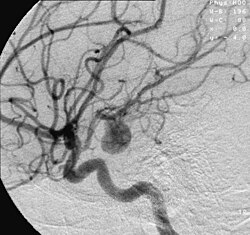Aneurysm

Editor-In-Chief: Prab R Tumpati, MD
Obesity, Sleep & Internal medicine
Founder, WikiMD Wellnesspedia &
W8MD medical weight loss NYC and sleep center NYC
| Aneurysm | |
|---|---|

| |
| Synonyms | |
| Pronounce | N/A |
| Specialty | Cardiology, Neurology, Vascular surgery |
| Symptoms | Often none, but can include pain, swelling, or pulsating mass |
| Complications | Rupture, hemorrhage, shock |
| Onset | |
| Duration | |
| Types | Aortic aneurysm, Cerebral aneurysm, Peripheral aneurysm |
| Causes | Atherosclerosis, hypertension, trauma, infection |
| Risks | Smoking, high blood pressure, genetic factors |
| Diagnosis | Ultrasound, CT scan, MRI, angiography |
| Differential diagnosis | Arteriovenous malformation, tumor |
| Prevention | Blood pressure control, smoking cessation, healthy diet |
| Treatment | Surgery, endovascular repair, medication |
| Medication | Beta blockers, statins |
| Prognosis | Varies depending on size and location |
| Frequency | Common, varies by type |
| Deaths | Significant if ruptured |
An aneurysm is a localized, abnormal, weak spot on a blood vessel wall that causes an outward bulging or ballooning of the arterial wall. Aneurysms can occur in any blood vessel, but they are most commonly found in the aorta (the main artery that carries blood from the heart to the rest of the body) and the arteries in the brain. Aneurysms can be life-threatening if they rupture, leading to serious complications, such as hemorrhagic stroke, internal bleeding, and even death.




Types of aneurysms[edit]
There are several types of aneurysms, including:
- Aortic aneurysm: Occurs in the aorta, which is divided into two segments, the thoracic aorta (in the chest) and the abdominal aorta. Aneurysms in these areas are called thoracic aortic aneurysms and abdominal aortic aneurysms, respectively.
- Cerebral aneurysm: Also known as a brain aneurysm, occurs in the blood vessels of the brain. Cerebral aneurysms are further classified based on their shape and size, such as saccular (berry) aneurysms, fusiform aneurysms, and giant aneurysms.
- Peripheral aneurysm: Occurs in blood vessels other than the aorta and brain, such as in the neck (carotid artery), groin (femoral artery), or behind the knee (popliteal artery).
Causes[edit]
The exact cause of aneurysms is not fully understood, but several factors are believed to contribute to their development, including:
- Genetic factors
- Aging
- Atherosclerosis (hardening of the arteries)
- High blood pressure
- Infection
- Injury or trauma
Some people may also be at a higher risk of developing an aneurysm due to a family history, smoking, or certain medical conditions, such as Marfan syndrome or Ehlers-Danlos syndrome.
Symptoms[edit]
Many aneurysms do not cause symptoms and are discovered incidentally during imaging tests for other conditions. However, large or growing aneurysms may press on surrounding tissues and cause symptoms, which vary depending on the location of the aneurysm:
- Aortic aneurysms may cause chest or back pain, shortness of breath, or difficulty swallowing.
- Cerebral aneurysms may cause headaches, vision problems, or facial pain.
- Peripheral aneurysms may cause pain, swelling, or a pulsating sensation in the affected area.
If an aneurysm ruptures, it can cause sudden and severe symptoms, such as intense pain, loss of consciousness, or even death.
Diagnosis[edit]
Aneurysms may be diagnosed using various imaging tests, such as:
- Ultrasound
- Computed tomography (CT) scan
- Magnetic resonance imaging (MRI)
- Angiography
Treatment[edit]
The treatment for aneurysms depends on their size, location, and risk of rupture. Small aneurysms with a low risk of rupture may be monitored with regular imaging tests. If an aneurysm is at a higher risk of rupture or is causing symptoms, treatment options may include:
- Surgery: Open surgery may be performed to repair or remove the aneurysm and replace the affected section of the blood vessel with a graft.
- Endovascular repair: A minimally invasive procedure in which a stent graft is inserted through a catheter and placed inside the aneurysm to reinforce the blood vessel wall and prevent rupture. This technique is commonly used for aortic aneurysms.
- Coiling or clipping: For cerebral aneurysms, coiling involves inserting a catheter through a blood vessel in the groin and guiding it to the aneurysm site. Tiny coils are then placed inside the aneurysm to promote clotting and seal off the aneurysm from the blood vessel. Clipping involves a craniotomy (opening the skull) and placing a small metal clip across the neck of the aneurysm to stop blood flow into it.
- Medication: Medications may be prescribed to manage risk factors, such as high blood pressure, and reduce the likelihood of aneurysm growth or rupture.
Prevention[edit]
While it may not be possible to prevent all aneurysms, certain lifestyle changes may help reduce the risk of developing an aneurysm or prevent an existing one from worsening:
- Maintain a healthy blood pressure by managing stress, exercising regularly, and eating a balanced diet.
- Quit smoking, as tobacco use is a major risk factor for aneurysm formation and rupture.
- Limit alcohol consumption, as excessive alcohol intake can contribute to high blood pressure and aneurysm development.
- Monitor and manage other medical conditions, such as diabetes and high cholesterol, which can increase the risk of aneurysm formation.
- Regular check-ups and screenings may also help detect aneurysms early, especially for those with a family history or known risk factors.
See also[edit]
Ad. Transform your life with W8MD's Budget GLP-1 injections from $75


W8MD offers a medical weight loss program to lose weight in Philadelphia. Our physician-supervised medical weight loss provides:
- Weight loss injections in NYC (generic and brand names):
- Zepbound / Mounjaro, Wegovy / Ozempic, Saxenda
- Most insurances accepted or discounted self-pay rates. We will obtain insurance prior authorizations if needed.
- Generic GLP1 weight loss injections from $75 for the starting dose.
- Also offer prescription weight loss medications including Phentermine, Qsymia, Diethylpropion, Contrave etc.
NYC weight loss doctor appointmentsNYC weight loss doctor appointments
Start your NYC weight loss journey today at our NYC medical weight loss and Philadelphia medical weight loss clinics.
- Call 718-946-5500 to lose weight in NYC or for medical weight loss in Philadelphia 215-676-2334.
- Tags:NYC medical weight loss, Philadelphia lose weight Zepbound NYC, Budget GLP1 weight loss injections, Wegovy Philadelphia, Wegovy NYC, Philadelphia medical weight loss, Brookly weight loss and Wegovy NYC
|
WikiMD's Wellness Encyclopedia |
| Let Food Be Thy Medicine Medicine Thy Food - Hippocrates |
Medical Disclaimer: WikiMD is not a substitute for professional medical advice. The information on WikiMD is provided as an information resource only, may be incorrect, outdated or misleading, and is not to be used or relied on for any diagnostic or treatment purposes. Please consult your health care provider before making any healthcare decisions or for guidance about a specific medical condition. WikiMD expressly disclaims responsibility, and shall have no liability, for any damages, loss, injury, or liability whatsoever suffered as a result of your reliance on the information contained in this site. By visiting this site you agree to the foregoing terms and conditions, which may from time to time be changed or supplemented by WikiMD. If you do not agree to the foregoing terms and conditions, you should not enter or use this site. See full disclaimer.
Credits:Most images are courtesy of Wikimedia commons, and templates, categories Wikipedia, licensed under CC BY SA or similar.
Translate this page: - East Asian
中文,
日本,
한국어,
South Asian
हिन्दी,
தமிழ்,
తెలుగు,
Urdu,
ಕನ್ನಡ,
Southeast Asian
Indonesian,
Vietnamese,
Thai,
မြန်မာဘာသာ,
বাংলা
European
español,
Deutsch,
français,
Greek,
português do Brasil,
polski,
română,
русский,
Nederlands,
norsk,
svenska,
suomi,
Italian
Middle Eastern & African
عربى,
Turkish,
Persian,
Hebrew,
Afrikaans,
isiZulu,
Kiswahili,
Other
Bulgarian,
Hungarian,
Czech,
Swedish,
മലയാളം,
मराठी,
ਪੰਜਾਬੀ,
ગુજરાતી,
Portuguese,
Ukrainian


